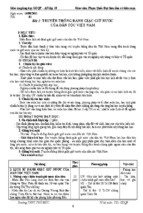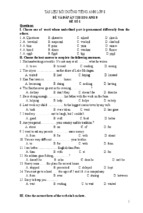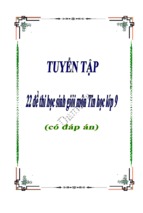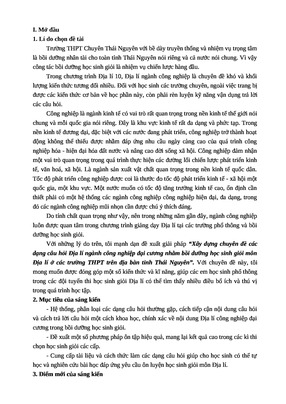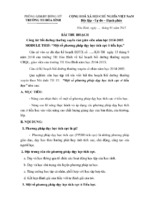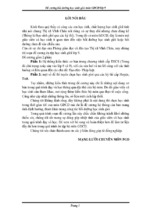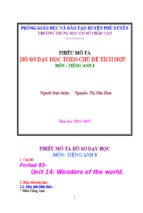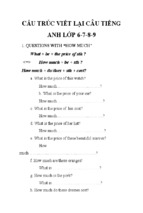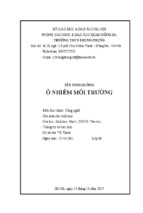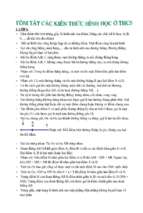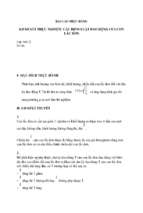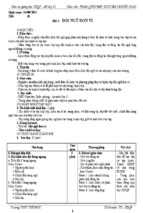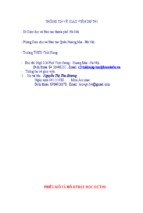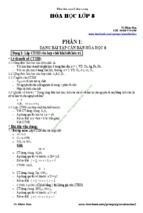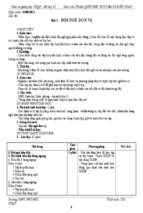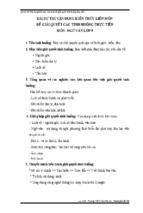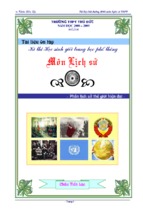Read the following passage and mark the letter A, B, C, or D on your answer sheet to indicate
the correct answer to each of the questions.
There are a number of natural disasters that can strike across the globe. Two that are frequently
linked to one another are earthquakes and tsunamis. Both of them can cause a great amount of
devastation when they hit. However, tsunamis are the direct result of earthquakes and cannot
happen without them.
The Earth has three main parts. They are the crust, the mantle, and the core. The crust is the outer
layer of the Earth. It is not a single piece of land. Instead, it is comprised of a number of plates.
There are a few enormous plates and many smaller ones. These plates essentially rest upon the
mantle, which is fluid. As a result, the plates are in constant - yet slow - motion. The plates may
move away from or towards other plates. In some cases, they collide violently with the plates
adjoining them. The movement of the plates causes tension in the rock. Over a long time, this
tension may build up. When it is released, an earthquake happens.
Tens of thousands of earthquakes happen every year. The vast majority are so small that only
scientific instruments can perceive them. Others are powerful enough that people can feel them,
yet they cause little harm or damage. More powerful earthquakes, however, can cause buildings,
bridges, and other structures to collapse. They may additionally injure and skill thousands of
people and might even cause the land to change it appearance.
Since most of the Earth's surface is water, numerous earthquakes happen beneath the planet's
oceans. Underwater earthquakes cause the seafloor to move. This results in the displacement of
water in the ocean. When this occurs, a tsunami may form. This is a wave that forms on the surface
and moves in all directions from the place where the earthquake happened. A tsunami moves
extremely quickly and can travel thousands of kilometres. As it approaches land, the water near
the coast gets sucked out to sea. This causes the tsunamis to increase in height. Minutes later, the
tsunami arrives. A large tsunami - one more than ten meters in height - can travel far inland. As it
does that, it can flood the land, destroy human settlements, and kill large numbers of people.
Câu 1. Which of the following statements does paragraph 1 support?
A. Earthquakes cause more destruction than tsunamis.
B. A tsunami happens in tandem with an earthquake.
C. The most severe type of natural disaster is an earthquake.
D. Earthquakes frequently take place after tsunamis do.
Câu 2. The word "it" in bold in paragraph 2 refers to___________.
A. the Earth B. the core
C. the crust D. the mantle
Câu 3. What is the passage mainly about?
A. How earthquakes and tsunamis occur.
B. What kind of damage natural disasters can cause.
C. Why tsunamis are deadlier than earthquakes.
D. When earthquakes are the most likely to happen.
Câu 4. The word "adjoining" in bold in paragraph 2 is closest in meaning to___________.
A. bordering B. residing
C. approaching
D. appearing
Câu 5. The word "perceive" in bold in paragraph 3 is closest in meaning to___________.
A. comprehend
B. detect
C. prevent
D. locate
Câu 6. Which of the following is true regarding the crust?
A. There many separate pieces that make it up.
B. It is the smallest of the Earth's three layers.
C. It is thicker on land than it is under the water.
D. The mantle beneath it keeps it from moving too much.
Câu 7. Based on the passage, what is probably true about tsunamis?
A. They kill more people each year than earthquakes.
B. They are able to move as fast as the speed of sound.
C. They cannot damage ships sailing on the ocean.
D. They can be deadly to people standing near shore.
Câu 8. Which of the following is NOT mentioned in paragraph 3 about earthquakes?
A. How many people they typically kill
C. What kind of damage they can cause
B. How often powerful ones take place
D. How severe the majority of them are
In the 1960s, The Beatles were probably the most famous pop group in the whole world. Since
then, there have been a great many groups that have achieved enormous fame, so it is perhaps
difficult now to imagine how sensational The Beatles were at that time. They were four boys from
the north of England and none of them had any training in music. They started by performing and
recording songs by black Americans and they had some success with these songs. Then they
started writing their own songs and that was when they became really popular. The Beatles
changed pop music. They were the first pop group to achieve great success from songs they had
written themselves. After that it became common for groups and singers to write their own songs.
The Beatles did not have a long career. Their first hit record was in 1963 and they split up in 1970.
They stopped doing live performances in 1966 because it had become too dangerous for them –
their fans were so excited that they surrounded them and tried to take their clothes as souvenirs!
However, today some of their songs remain as famous as they were when they first came out.
Throughout the world many people can sing part of a Beatles song if you ask them.
Câu 9. The passage is mainly about
A. Why the Beatles split up after 7 years
B. The Beatles’ fame and success
C. How the Beatles became more successful than other groups
D. Many people’s ability to sing a Beatles song
Câu 10. The four boys of the Beatles___________
A. Were at the same age
B. Came from a town in the north of England
C. Came from the same family
D. Received good training in music
Câu 11. The word “sensational” is closest in meaning to
A. shocking
B. bad C. notorious
D. popular
Câu 12. The first songs of the Beatles were _____
A. paid a lot of money
B. broadcast on the radio
C. written by themselves
D. written by black Americans
Câu 13. What is not true about the Beatles?
A. They became famous when they wrote their own songs
B. They had a long stable career
C. The members had no training in music
D. They were afraid of being hurt by fans
Câu 14. The Beatles stopped their live performances because
A. They spent more time writing their own songs
B. They did not want to work with each other
C. They had earned enough money
D. They were afraid of being hurt by fans.
Câu 15. The tone of the passage is that of________
A. neutral B. criticism C. admiration D. sarcasm
Many ants forage across the countryside in large numbers and undertake mass
migrations; these activities proceed because one ant lays a trail on the ground for the others
to follow. As a worker ant returns home after finding a source of food, it marks the route
by intermittently touching its stinger to the ground and depositing a tiny amount of trail
(5) pheromone – a mixture of chemicals that delivers diverse messages as the context changes.
These trails incorporate no directional information and may be followed by other ants in
either direction.
Unlike some other messages, such as the one arising from a dead ant, a food trail has to
be kept secret from members of other species. It is not surprising then that ant species use
(10) a wide variety of compounds as trail pheromones. Ants can be extremely sensitive to these
signals. Investigators working with the trail pheromone of the leafcutter ant Atta texana
calculated that one milligram of this substance would suffice to lead a column of ants three
times around Earth.
The vapor of the evaporating pheromone over the trail guides an ant along the way,
(15) and the ant detects this signal with receptors in its antennae. A trail pheromone will
evaporate to furnish the highest concentration of vapor right over the trail, in what is called
a vapor space. In following the trail, the ant moves to the right and left, oscillating from side
to side across the line of the trail itself, bringing first one and then the other antenna into
the vapor space. As the ant moves to the right, its left antenna arrives in the vapor space.
(20) The signal it receives causes it to swing to the left, and the ant then pursues this new course
until its right antenna reaches the vapor space. It then swings back to the right, and so
weaves back and forth down the trail.
Question 16. What does the passage mainly discuss?
A. The mass migration of ants
B. How ants mark and follow a chemical trail
C. Different species of ants around the world D. The information contained in pheromones
Question 17. The word “intermittently” in line 4 is closest in meaning to
A. periodically
B. incorrectly
C. rapidly
D. roughly
Question 18. The phrase “the one” in line 8 refers to a single
A. message
B. dead ant
C. food trail
D. species
Question 19. According to the passage, why do ants use different compounds as trail pheromones?
A. To reduce their sensitivity to some chemicals
B. To attract different types of ants
C. To protect their trail from other species
D. To indicate how far away the food is
Question 20. The author mentions the trail pheromone of the leafcutter ant in line 11 to point out
A. how little pheromone is needed to mark a trail
B. the different types of pheromones ants can produce
C. a type of ant that is common in many parts of the world
D. that certain ants can produce up to one milligram of pheromone
Question 21. According to the passage, how are ants guided by trail pheromones?
A. They concentrate on the smell of food.
B. They follow an ant who is familiar with the trail
C. They avoid the vapor spaces by moving in a straight line.
D. They sense the vapor through their antennae.
Question 22. The word “oscillating“ in line 17 is closest in meaning to
A. falling
B. depositing
C. swinging
D. starting
Question 23. According to the passage, the highest amount of pheromone vapor is found
A. in the receptors of the ants
B. just above the trail
C. in the source of food
D. under the soil along the trail
Martin Luther King, Jf., is well- known for his work in civil rights and for his many famous
speeches, among which is his moving “ I have a dream” speech. But fewer people know much
about King’s childhood. M.L., as he was called, was born in 1929 in Atlanta, Georgia, at the home
of his maternal grandfather. M.L.’s grandfather purchased their home on Auburn Avenue in 1909,
twenty years before M.L was born. His grandfather allowed the house to be used as a meeting
place for a number of organizations dedicated to the education and social advancement of blacks.
M.L. grew up in the atmosphere, with his home being used as a community gathering place, and
was no doubt influenced by it.
M.L.’s childhood was not especially eventfully. His father was a minister and his mother
was a musician. He was the second of three children, and he attended all black schools in a black
neighborhood. The neighborhood was not poor, however. Auburn Avenue was an area of banks,
insurance companies, builders, jewelers, tailors, doctors, lawyers, and other businesses and
services. Even in the face of Atlanta’s segregation, the district thrived. Dr. King never forgot the
community spirit he had known as a child, nor did he forget the racial prejudice that was a huge
barrier keeping black Atlantans from mingling with whites.
Question 24. What is the passage mainly about?
A. The prejudice that existed in Atlanta.
B. M.L.’s grandfather
C. Martin Luther King’s childhood.
D. The neighborhood King grew up in
Question 25. When was M.L. born?
A. in 1909
B. in 1929
C. in 1949
D. 20 years after his parents
had met.
Question 26. What is Martin Luthur King well- known for?
A. His publications.
B. His neighborhood. C. His childhood.
D. His work in civil
rights.
Question 27. According to the author, M.L. _______.
A. had a difficult childhood.
B. was a good musician as a child
C. loved to listen to his grandfather speak.
D. grew up in a relatively rich area of Atlanta.
Question 28. Which of the following statements is NOT true?
A. Auburn was a commercial areas.
B. M.L.’s grandfather built their home on Auburn Avenue in 1909.
C. M. L. grew up in a rich, black neighborhood.
D. M.L.’s childhood was uneventful.
Question 29. From the passage we can infer that:
A. M.L.’s father was a church member.
B. people gathered at M.L.’s to perform religious rituals.
C. M.L.’s father purchased their home on Auburn Avenue.
D. M.L. had a bitter childhood.
Question 30. M.L. was _______ by the atmosphere in which he grew up.
A. not affected at all
B. doubted
C. certainly influenced
D. prejudiced
"Did you see that?" Joe said to his friend Bill. "You're a great shooter!"
Bill caught the basketball and bounced it before throwing it again. The ball flew into the
net.
"Bill, you never miss!" Joe said admiringly.
"Unless I'm in a real game," Bill complained. "Then I miss all the time."
Joe knew that Bill was right. Bill performed much better when he was having fun with
Joe in the school yard than he did when he was playing for the school team in front of a large
crowd.
"Maybe you just need to practice more," Joe suggested.
"But I practice all the time with you!" Bill objected. He shook his head. "I just can't play
well when people are watching me."
"You play well when I'm watching," Joe pointed out.
"That's because I've known you since we were five years old," Bill said with a smile. "I'm
just not comfortable playing when other people are around."
Joe nodded and understood, but he also had an idea.
The next day Joe and Bill met in the school yard again to practice. After a few minutes,
Joe excused himself.
"Practice without me," Joe said to his friend. "I'll be back in a minute."
Joe hurried through the school building, gathering together whomever he could find—
two students, a math teacher, two secretaries, and a janitor. When Joe explained why he needed
them, everyone was happy to help.
Joe reminded the group to stay quiet as they all went toward the school's basketball court.
As Joe had hoped, Bill was still practicing basketball. He made five baskets in a row without
noticing the silent people standing behind him.
"Hey, Bill!" Joe called out finally.
Bill turned. A look of surprise came over his face.
"I just wanted to show you that you could play well with people watching you," Joe said.
"Now you'll have nothing to worry about for the next game!"
(From:
https://www.ets.org/toefl_junior/prepare/standard_sample_questions/language_form_and_meani
ng)
Câu 31: At the end of the story, all of the following people watch Bill practice EXCEPT
………………...
A. the basketball coach
B. a math teacher
C. a janitor
D. Joe
Câu 32: Bill is upset because ………………..
A. his team loses too many games.
B. he plays better in practice than he does during games.
C. the school yard is not a good place to practice.
D. Joe watches him too closely when he plays.
Câu 33: What does Joe decide to gather a group of people for?
A. To have more people see the next game
B. To show them Bill’s talent
C. To get more players for his team
D. To help Bill feel less nervous
Câu 34: What would be the best title for the story?
A. Practice Makes Perfect
B. Joe Joins the Team
C. Bill Wins the Big Game
D. Bill's Basketball Problem
Câu 35: In line 6, the word performed is closest in meaning to ………………...
A. played
B. changed
C. moved
D. acted
Câu 36: Why does the group have to be quiet when they go to the basketball court?
A. Because they do not want Bill to know they were there
B. Because the group needs to listen to Joe’s instructions
C. Because Joe is telling Bill what to do
D. Because Bill likes to practice alone
Câu 37: Why does Bill play well when Joe is watching him?
A. He is comfortable with Joe.
B. Joe tells him how to play better.
C. He does not know that Joe is there.
D. He wants to prove to Joe that he is a good player.
When another old cave is discovered in the south of France, it is not usually news.
Rather, it is an ordinary event. Such discoveries are so frequent these days that hardly anybody
pays heed to them. However, when the Lascaux cave complex was discovered in 1940, the world
was amazed. Painted directly on its walls were hundreds of scenes showing how people lived
thousands of years ago. The scenes show people hunting animals, such as bison or wild cats.
Other images depict birds and, most noticeably, horses, which appear in more than 300 wall
images, by far outnumbering all other animals.
Early artists drawing these animals accomplished a monumental and difficult task.
“They” did not limit themselves to the easily accessible walls but carried their painting materials
to spaces that required climbing steep walls or crawling into narrow passages in the Lascaux
complex.
Unfortunately, the paintings have been exposed to the destructive action of water and
temperature changes, which easily wear the images away. Because the Lascaux caves have many
entrances, air movement has also damaged the images inside. Although they are not out in the
open air, where natural light would have destroyed them long ago, many of the images have
deteriorated and are barely recognizable. To prevent further damage, the site was closed to
tourists in 1963, 23 years after it was discovered.
(From:
https://www.ets.org/toefl_junior/prepare/standard_sample_questions/language_form_and_meani
ng)
Câu 38: In line 12, the word “They” refers to ………………...
A. Walls
B. Animals C. Materials D. Artists
Câu 39: Based on the passage, what is probably true about the south of France?
A. It is home to rare animals.
B. It is known for horse-racing events.
C. It has attracted many famous artists.
D. It has a large number of caves.
Câu 40: Which title best summarizes the main idea of the passage?
A. Hidden Prehistoric Paintings
B. Determining the Age of French Caves
C. Wild Animals in Art
D. Exploring Caves Respectfully
Câu 41: Why was painting inside the Lascaux complex a difficult task?
A. It was completely dark inside.
B. The caves were full of wild animals.
C. Many painting spaces were difficult to reach.
D. Painting materials were hard to find.
Câu 42: In line 3, the words pays heed to are closest in meaning to ………………...
A. watches
B. discovers C. notices
D. buys
Câu 43: What does the passage say happened at the Lascaux caves in 1963?
A. Another part was discovered.
B. Visitors were prohibited from entering.
C. A new entrance was created.
D. A new lighting system was installed.
Câu 44: According to the passage, all of the following have caused damage to the paintings
EXCEPT ………………...
A. water
B. temperature changes
C. air movement
D. light
Câu 45: According to the passage, which animals appear most often on the cave walls?
A. Horses
B. Bison
C. Birds
D. Wild cats
Body postures and movements are frequently indicators of self-confidence, energy, fatigue,
or status. Cognitively, gestures operate to clarify, contradict, or replace verbal messages. Gestures
also serve an important function with regard to regulating the flow of conversation. For example,
if a student is talking about something in front of the class, single nods of the head from the teacher
will likely cause that student to continue and perhaps more elaborate. Postures as well as gestures
are used to indicate attitudes, status, affective moods, approval, deception, warmth, arid other
variables related to conversation interaction.
The saying “A picture is worth a thousand words” well describes the meaning of facial
expressions. Facial appearance – including wrinkles, muscle tone, skin coloration, and eye coloroffers enduring cues that reveal information about age, sex, race, ethnic origin, and status.
A less permanent second set of facial cues-including length of hair, hairstyle, cleanliness,
and facial hair-relate to an individual’s idea of beauty. A third group of facial markers are
momentary expressions that signal that cause changes in the forehead, eyebrows, eyelids, cheeks,
nose, lips, and chin, such as raising the eyebrows, wrinkling the brow, curling the lip.
Some facial expressions are readily visible, while others are fleeting. Both types can
positively or negatively reinforce the spoken words and convey cues concerning emotions and
attitudes.
Câu 46. Facial expressions __________.
A. cannot convey emotions
B. cannot reinforce spoken words
C. can only express negative attitudes
D. can be either visible or fleeting
Câu 47. Gestures __________.
A. can do nothing with a conversation
B. can clarify the meaning of verbal messages
C. may interrupt the flow of a conversation D. can end a conversation more quickly than
usual
Câu 48. According to the writer, “A picture is worth a thousand words” means __________.
A. a picture of a face is more valuable than a thousand words
B. a picture is more important than a thousand words
C. facial gestures can convey a lot of meanings
D. he has just bought a picture with a thousand words on it
Câu 49. How many categories of facial expressions are mentioned?
A. 2
B. 3
C. 4
D. 5
Câu 50. A nod of the head from the teacher will likely ask his student to __________ what he is
saying.
A. go on
B. give up
C. put off
D. throwaway
“Where is the university?” is a question many visitors to Cambridge ask, but no one can
give them a clear answer, for there is no wall to be found around the university. The university is
the city. You can find the classroom buildings, libraries, museums and offices of the university all
over the city. And most of its members are the students and teachers or professors of the thirtyone colleges. Cambridge is already a developing town long before the first students and teachers
arrived 800 years ago. It grew up by the river Granta, as the Cam was once called. A bridge was
built over the river as early as 875.
In the fourteenth and fifteenth centuries, more and more land was used for college
buildings. The town grew faster in the nineteenth century after the opening of the railway in 1845.
Cambridge became a city in 1951 and now it has the population of over 100000. Many young
students want to study at Cambridge. Thousands of people from all over the world come to visit
the university town. It has become a famous place all around the world.
Câu 51. Why did people name Cambridge the “city of Cambridge”?
A. Because the river was very well-known.
B. Because there is a bridge over the Cam.
C. Because it was a developing town.
D. Because there is a river named Granta.
Câu 52. From what we read we know that now Cambridge is _______.
A. visited by international tourists
B. a city without wall
C. a city of growing population
D. a city that may have a wall around
Câu 53. Around what time did the university begin to appear?
A. In the 8th century B. In the 13th century
C. In the 9th century D. In the 15th century
Câu 54. Why do most visitors come to Cambridge?
A. To see the university
B. To study in the colleges in Cambridge
C. To find the classroom buildings
D. To use the libraries of the university
Câu 55. After which year did the town really begin developing?
A. 800 B. 875 C. 1845
D. 1951
Accustomed though we are to speaking of the films made before 1927 as “silent”, the film
has never been, in the full sense of the word, silent. From the very beginning, music was regarded
as an indispensable accompaniment; when the Lumiere films were shown at the first public film
exhibition in the United States in February 1896, they were accompanied by piano improvisations
on popular tunes. At first, the music played bore no special relationship to the films; an
accompaniment of any kind was sufficient. Within a very short time, however, the incongruity of
playing lively music to a solemn film became apparent, and film pianists began to take some care
in matching their pieces to the mood of the film.
As movie theaters grew in number and importance, a violinist, and perhaps a cellist, would
be added to the pianist in certain cases, and in the larger movie theaters small orchestras were
formed. For a number of years the selection of music for each film program rested entirely in the
hands of the conductor or leader of the orchestra, and very often the principal qualification for
holding such a position was not skill or taste so much as the ownership of a large personal library
of musical pieces. Since the conductor seldom saw the films until the night before the y were to be
shown (if, indeed, the conductor was lucky enough to see them then), the musical arrangement
was normally improvised in the greatest hurry.
To help meet this difficulty, film distributing companies started the practice of publishing
suggestions for musical accompaniments. In 1909, for example, the Edison Company began
issuing with their films such indications of mood as “pleasant’, “sad”, “lively”. The suggestions
became more explicit, and so emerged the musical cue sheet containing indications of mood, the
titles of suitable pieces of music, and precise directions to show where one piece led into the next.
Certain films had music especially composed for them. The most famous of these early special
scores was that composed and arranged for D. w. Griffith’s film Birth of a Nation, which was
released in 1915.
Câu 56: It may be inferred from the passage that the first musical cue sheets appeared around
_______ .
A. 1896
B. 1909
C. 1915
D. 1927
Câu 57: The word “them” refers to _______ .
A. films
B. years
C. pieces
D. hands
Câu 58: Which of the following notations is most likely to have been included on a musical cue
sheet of the early 1900's?
A. “Key of c major” B. “Directed by D. w. Griffith”
C. “Calm, peaceful” D.
“Piano, violin”
Câu 59: According to the passage, what kind of business was the Edison Company?
A. It published musical arrangements.
B. It made musical instruments.
C. It distributed films. D. It produced electricity.
Câu 60: The passage mainly discusses music that was _______ .
A. performed before the showing of a film
B. played during silent films
C. specifically composed for certain movie theaters
D. recorded during film exhibitions
Câu 61: The word “composed” is closest in meaning to _______ .
A. selected
B. combined C. played
D. created
Câu 62: The word “scores” most likely mean _______ .
A. successes B. totals
C. groups of musicians D. musical compositions
Câu 62: It can be inferred that orchestra conductors who worked in movie theaters needed to
_______ .
A. be able to compose original music B. have pleasant voices
C. be able to play many instruments D. be familiar with a wide variety of music
At the beginning of the nineteenth century, the American educational system was
desperately in need of reform. Private schools existed, but only for the very rich. There were very
few public schools because of the strong sentiment that children who would grow up to be laborers
should not “waste” their time on education but should instead prepare themselves for their life’s
work. It was in the face of this public sentiment that educational reformers set about their task.
Horace Mann, probably the most famous of the reformers, felt that there was no excuse in a
republic for any citizen to be uneducated. As Manager of Education in the state of Massachusetts
from 1837 to 1848, he initiated various changes, which were soon matched in other school districts
around the country. He extended the school year from five to six months and improved the quality
of teachers by instituting teacher education and raising teacher salaries. Although these changes
did not bring about a sudden improvement in the educational system, they at least increased public
awareness as to the need for a further strengthening of the system.
Câu 64: The passage implied that to go to a private school, a student needed _______ .
A. a lot of money
B. a high level of intelligence
C. good grades
D. a strong educational background
Câu 65: According to the passage, Horace Mann wanted a better educational system for
Americans because _______ .
A. Massachusetts residents needed something to do with their spare time
B. there was no excuse in a republic for any citizen to be uneducated
C. education at the time was so cheap
D. people had nothing else to do except go to school
Câu 66: The word “reformers” in the passage mostly means _______ .
A. people who really enjoy teaching B. people who believe that education is wasted
C. people who work for the government
D. people who try to change things for the
better
Câu 67: From 1837 to 1848, Horace Mann _______ .
A. worked as a headmaster in a school in the state of Massachusetts
B. funded many projects to improve the educational system for Americans
C. managed education in the state of Massachusetts
D. raised money for the educational development in Massachusetts
Câu 68: The word “salaries” is closest in meaning to _______ .
A. money
B. wages
C. school fee D. cost
Câu 69: The word “they” in the passage refers to _______ .
A. these changes
B. sudden improvement
C. educational system D. public awareness
Câu 70: According to the passage, which sentence is NOT TRUE?
A. Horace Mann was a famous US educational reformer.
B. Horace Mann brought about changes in many schools in the US.
C. Horace Mann began raising teachers’ salaries.
D. Horace Mann suggested schools prepare children for their life’s work.
Because writing has become so important in our culture, we sometimes think of it as more
real than speech. A little thought, however, will show why speech is primary and writing secondary
to language. Human beings have been writing at least 5,000 years, but they have been talking for
much longer, doubtless ever since there have been human beings. When writing developed, it was
derived from and represented speech, although imperfectly. Even today, there are spoken
languages that have no written form. Furthermore, we all learn to talk well before we learn to
write; any child who is not severely handicapped physically or mentally will learn to talk: a normal
man cannot be prevented from doing so. On the other hand, it takes a special effort to learn to
write; in the past, many intelligent and useful members of society did not acquire the skill, and
even today many who speak languages with writing systems never learn to read or write while
some who learn the rudiments of those skills do so imperfectly.
To affirm the primacy of speech over writing is not to disparage the later. One advantage
writing has over speech is that it is more permanent and makes possible the records that any
civilization must have. Thus, if speaking makes us human, writing makes us civilized.
Question 71: According to paragraph 1, the author of the passage argues that _______
A writing has become too important in today's society.
B. speech is more basic to language than writing.
C. everyone who learns to speak must learn to writing.
D. all languages should have a written form.
Question 72: The word “doubtless” in the passage mostly means _______ .
A. “almost uncertainly”
B. “almost certainly”
C. “almost impossibly”
D. “almost doubtly”
Question 73: According to the passage, writing _______ .
A. is imperfect, but less than speech B. represents speech, but not perfectly
C. developed from imperfect speech D. is represented perfectly by speech
Question 74: In order to show that learning to write requires effort, the author gives the example
of _______ .
A. people who learn the rudiments of speech B. people who speak many languages
C. intelligent people who couldn't write
D. severely handicapped children
Question 75: The word “acquire” in the passage mostly means _______ .
A. “help somebody learn something by giving information about it”
B. “gain something by our own efforts or ability”
C. “become aware of something by hearing about it”
D. “develop a natural ability or quality so that it improves”
Question 76: The word “disparage” in the passage mostly means _______ .
A. “think that something is more important”
B. “make something seem more important”
C. “think about something carefully”
D. “suggest that something is not important or valuable”
Question 77: In the author's judgment _______ .
A. writing has more advantages than speech
B. speech is essential but writing has important benefits
C. speech conveys ideas less accurately than writing does
D. writing is more real than speech.
Question 78: According to the author, one mark of a civilized society is that if _______ .
A. affirms the primacy of speech over writing
B. affirms the primacy of writing over speech
C. teaches its children to speak perfectly
D. keeps written records
After two decades of growing student enrollments and economic prosperity, business
schools in the United States have started to face harder times. Only Harvard's MBA School has
shown a substantial increase in enrollment in recent years. Both Princeton and Stanford have seen
decreases in their enrollments. Since 1990, the number of people receiving Masters in Business
Administration (MBA) degrees, has dropped about 3 percent to 75,000, and the trend of lower
enrollment rates is expected to continue.
There are two factors causing this decrease in students seeking an MBA degree. The first
one is that many graduates of four-year colleges are finding that an MBA degree does not guarantee
a plush job on Wall Street, or in other financial districts of major American cities. Many of the
entry-level management jobs are going to students graduating with Master of Arts degrees in
English and the humanities as well as those holding MBA degrees. Students have asked the
question, "Is an MBA degree really what I need to be best prepared for getting a good job?" The
second major factor has been the cutting of American payrolls and the lower number of entry-level
jobs being offered. Business needs are changing, and MBA schools are struggling to meet the new
demands.
Question 79: What is the main focus of this passage?
A. jobs on Wall Street
B. types of graduate degrees
C. changes in enrollment for MBA school
D. how schools are changing to reflect the economy
Question 80: The phrase "two decades" in line 1 refers to a period of _______.
A. 10 years
B. 20 years
C. 50 years
D. 100 years
Question 81: The word "prosperity" in line 1 could be best replaced by which of the following?
A. success
B. surplus
C. nurturing
D. education
Question 82: Which of the following business schools has NOT shown a decrease in enrollment?
A. Princeton B. Harvard
C. Stanford
D. Yale
Question 83: As used in paragraph 2, the word "seeking" could best be replaced by which of the
following?
A. examining B. avoiding
C. seizing
D. pursuing
Question 84: According to the passage, what are two causes of declining business school
enrollments?
A. lack of necessity for an MBA and an economic recession
B. low salary and foreign competition
C. fewer MBA schools and fewer entry-level jobs
D. declining population and economic prosperity
Question 85: Which of the following might be the topic of the next paragraph?
A. MBA schools' efforts to change
B. future economic predictions
C. a history of the recent economic changes
D. descriptions of non-MBA graduate programs
The biological community changes again as one moves from the city to the suburbs.
Around all cities is a biome called the "suburban forest". The trees of this forest are species that
are favored by man, and most of them have been deliberately planted. Mammals such as rabbits,
skunks, and opossums have moved in from the surrounding countryside. Raccoons have become
experts at opening garbage cans, and in some places even deer wander suburban thoroughfares.
Several species of squirrel get along nicely in suburbia, but usually only one species is predominant
in any given suburb -fox squirrels in one place, red squirrels in another, gray squirrels in a third for reasons that are little understood. The diversity of birds in the suburbs is great, and in the South,
lizards thrive in gardens and even houses. Of course, insects are always present. There is an odd
biological sameness in these suburban communities. True, the palms of Los Angeles are missing
from the suburbs of Boston, and there are species of insects in Miami not found in Seattle. But
over wide stretches of the United States, ecological conditions in suburban biomes vary much less
than do those of natural biome. And unlike the natural biomes, the urban and suburban
communities exist in spite of, not because of, the climate
Question 86. If there was a preceding paragraph to this passage it would most likely be concerned
with which of the following topics?
A. The migration from cities to suburbs.
B. The biological community in urban areas.
C. The mammals of the American countryside.
D. The history of American suburbs.
Question 87. The author implies that the mammals of the "suburban forest" differ from most
species of trees there in which of the following ways?
A. They were not deliberately introduced.
B. They are considered undesirable by humans.
C. They are represented by a greater number of species.
D. They have not fully adapted to suburban conditions.
Question 88. The word “thoroughfares” is closet in meaning to
A. neighborhoods
B. lawns
C. open spaces
D. streets
Question 89. Which of the following conclusions about squirrels is supported by information in
the passage?
A. The competition among the three species is intense.
B. Fox squirrels are more common than grey or red squirrels.
C. Two species of squirrels seldom inhabit the same suburb.
D. The reasons why squirrels do well in the suburbs are unknown
Question 90. The word "thrive" is closest in meaning to
A. remain
B. flourish
C. reproduce D. survive
Question 91. The word "odd" is closest in meaning to
A. unusual
B. appropriate C. unforgettable
D. expected
Question 92. Which of the following best expresses the main idea of the second paragraph of the
passage?
A. Biological communities in East Coast suburbs differ greatly from those on the West
Coast
B. The suburban forest occupies an increasingly large segment of the American landscape
C. Suburbs in the Unites States have remarkably similar biological communities
D. Natural biomes have been studied more than suburban biomes
Question 93. What does the author imply about the effect of climate in the suburban biome?
A. It is more noticeable than the effect of climate on the urban biome
B. It is not as important as it once was
C. It depends on the location of the biome
D. It is not as dramatic as the effect of climate on natural biomes
Four West Indian geckos, with human assistance, have recently entered the United States.
The yellowheaded gecko, the ashy gecko, the reef gecko, and the ocellated gecko are presently
inhabiting the tropical areas of the Keys and the tip of southern Florida. The Mediterranean gecko
also arrived along the Gulf coast some time ago, via the West Indies. The only other geckos in the
United States live in the Southwest. In extreme southern California, the leaf-gingered gecko lives
in dry, rocky country and scampers over boulders at night, hiding by day in crevices. It has a
slender, tapered tail and stalks insects by raising itself high on its legs, cocking its head, and
twitching its tail nervously before leaping on its prey. In courtship, the tail is also waved by the
male as he approaches the female.
Although most lizards are excellent climbers, the geckos are able to walk on smooth
surfaces with the help of unique clinging devices under the toes. Also, the undersides of most
geckos have pads of large scales, each of which bear microscopic hairs with hundreds of branches
having minute, blunt ends that press against the surface that the gecko is on, enabling the gecko
to cling to almost any surface. Like other lizards, geckos have the ability to shed their tails if
attacked by an enemy. They stump heels and a new tail is grown in approximately the same shape
as the original. Unlike most lizards, most geckos have no moveable eyelids. The nocturnal geckos
have vertical pupils, which contract in bright light. All geckos, except several New Zealand
species, lay eggs. The eggs have a tough, white shell and are laid under stones, behind window
shutters or under bark.
Question 94. In line 1, the author uses the words “human assistance” to mean .
A. West Indian geckos were raised by human
B. people brought West Indian geckos to these areas s
C. humans saved West Indian geckos from extinction
D. West Indian geckos reached these places while escaping from humans
Question 95. According to the passage, the banded gecko .
A. lives in dry, rocky country B. has a short, stout tail
C. recently entered the United States D. is nocturnal
Question 96. Which of the following is closest in meaning to the word “nocturnal”?
A. quick-moving
B. very poisonous
C. cold-blooded
D. active at night
Question 97. The word “minute” is closest in meaning to...
A. very quick B. very small C. extremely hard
Question 98. The author’s main purpose is to...
A. compare lizards and geckos
B. describe the behavior and environment of geckos
C. analyze the life of gecko
D. illustrate the habits of geckos
D. extremely fast
Question 99. The passage would be most interest to...
A. statisticians B. history professors C. biology students
D. social scientists
Question 100. What is the most likely subject of the paragraph following this passage?
A. Information on how baby geckos hatch and develop
B. The story of the journeys of West Indian geckos
C. A description of geckos native to North America
D. A history of the southern California desert
Ever since humans have inhabited the earth, they have made use of various forms of
communication. Generally, this expression of thoughts and feelings has been in the form of oral
speech. When there is a language barrier, communication is accomplished through sign language
in which motions stand for letters, words, and ideas. Tourists, the deaf, and the mute have had to
resort to this form of expression. Many of these symbols of whole words are very picturesque and
exact and can be used internationally, spelling, however, cannot.
Body language transmits ideas or thoughts by certain actions, either intentionally or
unintentionally. A wink can be a way of flirting or indicating that the party is only joking. A nod
signifies approval, while shaking the head indicates a negative reaction.
Other forms of nonlinguistic language can be found in Braille (a system of raised dots read
with the fingertips), signal flags, Morse code, and smoke signals. Road maps and picture signs also
guide, warm, and instruct people. While verbalization is most common form of language, other
systems and techniques also express human thoughts and feelings.
Question 101. Which form other than oral speech would be the most commonly used among blind
people?
A. Picture signs
B. Braille
C. Signal flags D. Body language
Question 102. The word “these” I the first paragraph refers to _______ .
A. thoughts and feelings
B. tourists
C. the deaf and the mute
D. sign language motions
Question 103. Sign language is said to be very picturesque and exact and can be used
internationally EXCEPT for _______ .
A. spelling
B. ideas
C. whole words
D. expressions
- Xem thêm -


